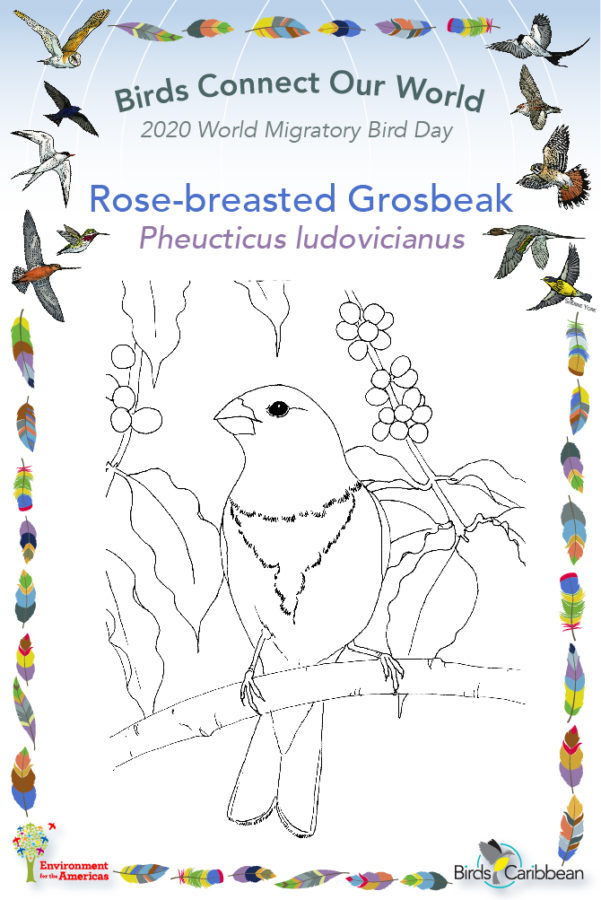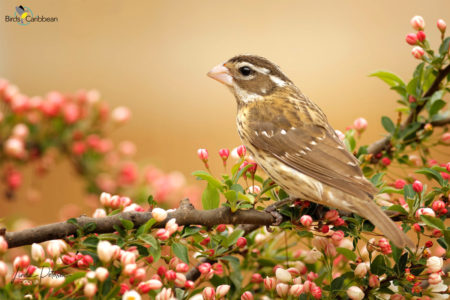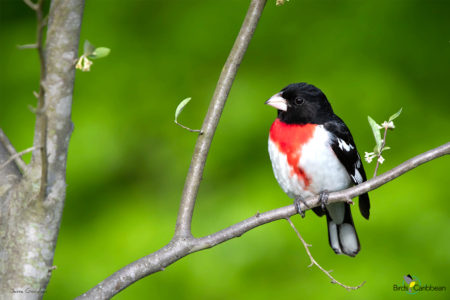Celebrate World Migratory Bird Day (WMBD) with us in our virtual “Birds Connect Our World” edition! Have fun learning about a new migratory bird every day. We have colouring pages, puzzles, activities, and more. Download for free and enjoy nature with your family at home.

Migratory Bird of the Day: Rose-breasted Grosbeak

These stocky looking birds have whitish, heavy cone-shaped bills, perfect for cracking open seeds and eating berries. Male Rose-breasted Grosbeaks are very eye-catching. They have a bright rosy-red triangle on their breast, a black head and back, white belly and rump, and broad white wing-bars. Females are striped olive brown above, and buffy underneath with brown streaking on the breast and flanks. They have a broad white eyebrow bordered by a dark crown and whitish wing bars. The large pale bill and strong face pattern helps to identify females.
Rose-breasted Grosbeaks breed in deciduous woods across most of Canada and North Eastern parts of the US. This species is a long-distance migrant, travelling south in the fall to spend the winter in Central America, northern South America, and the Caribbean. They often migrate in small groups, sometimes joining other types of birds like tanagers and thrushes.
Rose-breasted Grosbeaks are most commonly seen in the Caribbean during migration, in October or April, as individuals stopover on their journeys south or back north. Others will spend the whole winter here. They are most commonly seen in the Bahamas, Cuba, Jamaica, and Cayman Islands. They are less common in Hispaniola, Puerto Rico, and the rest of the Lesser Antilles.
Rose-breasted Grosbeaks have a varied diet. During migration they mostly eat fruits, but on the breeding and wintering grounds, they also eat seeds, flowers, and insects. They glean insects from leaves or fly out to catch them in mid-air. Rose-breasted Grosbeaks can be found in woodlands, coffee plantations, at forest edges and sometimes in gardens. They will visit feeders so be sure to keep them stocked with their favorite foods, including sunflower seeds, safflower seeds, and raw peanuts. Learn more about this species, including its range, photos, and calls here.
Colour in the Rose-breasted Grosbeak!
Download the page from Migratory Birds of the West Indies Colouring Book. Use the photos below as your guide, or you can look up pictures of the bird online or in a bird field guide if you have one. Share your coloured-in page with us by posting it online and tagging us @BirdsCaribbean #WMBD2020Carib
Listen to the calls of the Rose-breasted Grosbeak
The calls of the Rose-breasted Grosbeak a high-pitched metallic sounding “Chink”
Puzzle of the Day
Click on the images below to do the puzzles. You can make the puzzle as easy or as hard as you like – for example, 6, 8, or 12 pieces for young children, all the way up to 1,024 pieces for those that are up for a challenge!


Activity of the Day
FOR KIDS: Can you find all the words in our Rose-breasted Grosbeak word search? All the words you need to find are linked to the appearance, behaviour, foods or locations of this species. Find the answers here.
FOR KIDS AND ADULTS:
- Take a walk and see if you can spot any migratory birds, maybe you will see a Rose-breasted Grosbeak or another colorful migratory species. Use a bird field guide or the FREE Merlin bird ID app to help you identify the birds you are seeing.
- Enjoy the videos below of the Rose-breasted Grosbeaks feeding! The first video shows a male bird feeding on seeds, you can see him breaking them open with his heavy bill. The second shows some females, that are brown colored and steaked looking, eating fruits; this species will also eat insects. In spring male Rose-breasted Grosbeaks have a beautiful fluting song, you can hear it in the final video.
- Visit MigratoryBirdDay.org for many more free activities and resources to learn about migratory birds, their threats and conservation actions you can take.

